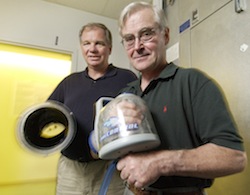H&S Discoveries
The synthesis of teaching and research is fundamental to the pursuit of knowledge at the School of Humanities and Sciences. All faculty do scholarly research, often in partnership with their colleagues, graduate students, and advanced undergraduates.
These collaborations have led to remarkable discoveries and inventions, some of which have changed our understanding of life. Here is a sampling of findings by H&S scholars that have made a difference:
Deciphering photosynthesis
In 1928, Dutch microbiologist Cornelis B. van Niel joined the faculty at Stanford’s
Hopkins Marine Station. Regarded as the father of microbiology in the United States, van Niel made key discoveries about the chemical mechanisms of photosynthesis. Stanford biochemist Arthur Kornberg, who would go on to win a Nobel in Medicine in 1959 for his research into the structure of DNA, took a popular summer course that van Niel taught undergraduates for 30 years. Later, Kornberg credited the class for stimulating his interest in microbiology.

Klystron tube
In the 1930s, brothers Russell (BA ’25, MA ’27) and Sigurd Varian started working as research associates in the physics department with professor William W. Hansen, (BA ’29, PhD ’33). In 1937, the three developed the klystron tube, which generated high-frequency short wavelength signals. This discovery paved the way for the invention of airborne radar, which helped crush Hitler’s Luftwaffe during World War II. The klystron also facilitated the development of commercial air navigation, satellite communication, and high-energy particle accelerators.

Contraceptive Pill
In 1951, chemist Carl Djerassi synthesized progestin norethindrone, a hormone that led to development of the Pill, the first oral contraceptive for women. Djerassi, a professor emeritus, also developed non-insecticidal pest control by using modified growth hormones to prevent insects from maturing from larvae to the pupal and adult stages.

Computer-aided instruction
In 1966, philosophy professor Patrick Suppes and psychology professor Richard Atkinson of Stanford’s Institute for Mathematical Studies in the Social Sciences introduced the concept of computer-aided instruction. Children at Brentwood Elementary School in East Palo were among the first in the nation to do interactive math and reading lessons using a computer. The Education Program for Gifted Youth (EPGY) is a descendant of those early experiments.
Digital sound synthesis
In 1967, John Chowning (DMA ’66) discovered the frequency modulation (FM) synthesis algorithm for generating sounds digitally. In 1973, Stanford licensed the discovery to Yamaha, and Chowning worked with the company to develop the music synthesizer. This technology became a de facto standard for sound chips and is used for many cell phone ringtones today. Chowning is a music professor emeritus
String theory
String theory, an attempt to provide a complete mathematical description of the fundamental structure of the universe, was proposed by Leonard Susskind, a physics professor, and Yoichiro Nambu, in 1969. While humans observe three dimensions of space and one of time, string theory posits 10 dimensions of space and one of time. The extra dimensions are balled up, or compactified, into dimensions too small to detect but whose structures are important to the laws of physics.

New forms of life on earth
In 1977, geology professor Tjeerd van Andel and two colleagues discovered underwater hot springs along the Galápagos Rift at the bottom of the Pacific. They found that the 10,000-foot-deep vents support a community of tube worms, giant clams, and other previously unknown species.
Fiber optic amplifiers
In the 1980s, H. John Shaw, professor of applied physics, and Michel Digonnet, senior research engineer in applied physics, developed the fiber optic amplifiers used in telephone and digital communications. As signals pass through the fiber, they get weaker—the amplifier enables them to go much farther. The invention enabled the bandwidth explosion in optical communications and telecommunications essential to the Internet. Shaw, who was Stanford’s most prolific inventor, also invented the fiber-optic gyroscope used in navigation systems. During his four decades on campus, Shaw was awarded about 100 U.S. patents, mostly in the field of photonics. He died in 2006.

The Glove
Biologists H. Craig Heller and Dennis Grahn invented this device to cool overheated muscles, allowing them to work harder and longer. Unlike the conventional approach of cooling the body from outside in, the Glove works by cooling the body from the inside out. The device, which professor Heller and Grahn, a senior research scientist, started developing in the 1980s, creates an airtight seal around the wrist. It then pulls blood into the palm of the hand and cools it before returning it to the heart and overheated muscles and organs. Elite athletes, firefighters, and the U.S. military have used the Glove, which is distributed by AVAcore Technologies.
Genome sequencing
Christopher Burge, (PhD ’97, computational biology), and math professor Samuel Karlin developed a statistical model in 1997 to assist in the sequencing of DNA. The software program, called GenScan, has been licensed to more than 100 companies for gene sequence prediction.

Establishing link between human activity and global warming
In 2007, the Nobel Peace Prize was awarded to former Vice President Al Gore and the Intergovernmental Panel on Climate Change (IPCC), a United Nations network of 2,000 scientists that included Stanford faculty. Gore and the IPCC were recognized “for efforts to build up and disseminate greater knowledge about man-made climate change, and to lay the foundations for the measures that are needed to counteract such change.” H&S professors Stephen Schneider, Thomas Heller, and Chris Field, and senior fellow Terry Root were key authors of several IPCC reports.

